What Denominations Do I Want In My Register
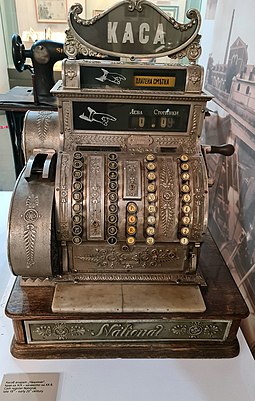
National cash register from the end of the 19th century, National History Museum, Sofia.
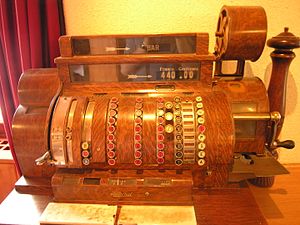
Antique crank-operated cash register
A greenbacks register, sometimes called a till or automated money treatment system, is a mechanical or electronic device for registering and computing transactions at a signal of sale. Information technology is ordinarily attached to a drawer for storing cash and other valuables. A modern cash register is commonly attached to a printer that tin print out receipts for record-keeping purposes.
History [edit]

An early on mechanical cash register was invented by James Ritty and John Birch post-obit the American Civil War. James was the owner of a saloon in Dayton, Ohio, Us, and wanted to end employees from pilfering his profits.[3] The Ritty Model I was invented in 1879 subsequently seeing a tool that counted the revolutions of the propeller on a steamship.[4] With the help of James' blood brother John Ritty, they patented it in 1883.[5] [half dozen] It was called Ritty'south Incorruptible Cashier and it was invented to stop cashiers from pilfering and eliminate employee theft and embezzlement.[7]
Early on mechanical registers were entirely mechanical, without receipts. The employee was required to ring upwardly every transaction on the register, and when the total primal was pushed, the drawer opened and a bong would ring, alerting the director to a sale taking place. Those original machines were cipher only simple calculation machines.
Since the registration is done with the process of returning modify, according to Beak Bryson odd pricing came about because by charging odd amounts like 49 and 99 cents (or 45 and 95 cents when nickels are more used than pennies), the cashier very probably had to open up the till for the penny change and thus announce the sale.[8]

Shortly after the patent, Ritty became overwhelmed with the responsibilities of running two businesses, and then he sold all of his interests in the cash register business organization to Jacob H. Eckert of Cincinnati, a cathay and glassware salesman, who formed the National Manufacturing Company. In 1884 Eckert sold the company to John H. Patterson, who renamed the company the National Cash Register Company and improved the cash register past calculation a paper roll to record sales transactions, thereby creating the journal for internal bookkeeping purposes, and the receipt for external bookkeeping purposes. The original purpose of the receipt was enhanced fraud protection. The business owner could read the receipts to ensure that cashiers charged customers the correct corporeality for each transaction and did non embezzle the cash drawer.[9] It too prevents a customer from defrauding the business by falsely challenge receipt of a lesser amount of change or a transaction that never happened in the first place. The offset show of an bodily cash register was used in Coalton, Ohio, at the former mining company.
In 1906, while working at the National Cash Register company, inventor Charles F. Kettering designed a cash register with an electrical motor.


Various types of modern greenbacks registers.
A leading designer, builder, manufacturer, seller and exporter of cash registers from the 1950s until the 1970s was London-based (and afterwards Brighton-based[10]) Gross Cash Registers Ltd.,[eleven] [12] founded by brothers Sam and Henry Gross. Their cash registers were particularly popular around the time of decimalisation in U.k. in early 1971, Henry having designed one of the few known models of cash annals which could switch currencies from £sd to £p and then that retailers could easily change from one to the other on or later on Decimal 24-hour interval. Sweda as well had decimal-set registers where the retailer used a special cardinal on Decimal Mean solar day for the conversion.
In current use [edit]
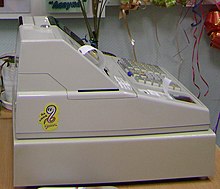
In some jurisdictions the constabulary also requires customers to collect the receipt and keep it at to the lowest degree for a brusque while after leaving the shop,[13] [14] again to check that the shop records sales, and so that it cannot evade sales taxes.
Often cash registers are attached to scales, barcode scanners, checkstands, and debit card or credit carte du jour terminals. Increasingly, dedicated cash registers are being replaced with general purpose computers with POS software. Cash registers utilise bitmap characters for printing.[15]
Today, point of auction systems scan the barcode (usually EAN or UPC) for each item, retrieve the cost from a database, calculate deductions for items on sale (or, in British retail terminology, "special offer", "multibuy" or "purchase one, get 1 complimentary"), calculate the sales tax or VAT, summate differential rates for preferred customers, concretize inventory, time and date stamp the transaction, record the transaction in item including each item purchased, record the method of payment, keep totals for each product or type of production sold too as total sales for specified periods, and exercise other tasks besides. These POS terminals will often besides identify the cashier on the receipt, and carry additional information or offers.
Currently, many cash registers are individual computers. They may be running traditionally in-house software or general purpose software such as DOS. Many of the newer ones have bear on screens. They may exist continued to computerized point of sale networks using whatever blazon of protocol. Such systems may be accessed remotely for the purpose of obtaining records or troubleshooting. Many businesses also use tablet computers every bit cash registers, utilizing the sale system every bit downloadable app-software.[xvi]
Cash drawer [edit]
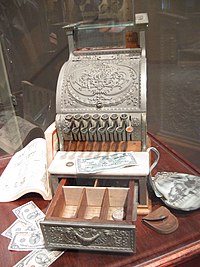
Greenbacks registers include a cardinal labeled "No Auction", abbreviated "NS" on many modern electronic cash registers. Its function is to open the drawer, printing a receipt stating "No Sale" and recording in the register log that the register was opened. Some cash registers require a numeric countersign or physical primal to be used when attempting to open the till.
A greenbacks register's drawer tin can only be opened by an instruction from the greenbacks annals except when using special keys, mostly held by the owner and some employees (e.g. managing director). This reduces the amount of contact near employees accept with greenbacks and other valuables. Information technology also reduces risks of an employee taking coin from the drawer without a record and the owner's consent, such every bit when a customer does not expressly inquire for a receipt just still has to exist given modify (cash is more hands checked confronting recorded sales than inventory).
A greenbacks drawer is unremarkably a compartment underneath a greenbacks register in which the greenbacks from transactions is kept. The drawer typically contains a removable till. The till is usually a plastic or wooden tray divided into compartments used to store each denomination of depository financial institution notes and coins separately in order to make counting easier. The removable till allows money to be removed from the sales flooring to a more secure location for counting and creating bank deposits. Some modern greenbacks drawers are individual units separate from the residual of the cash annals.
A cash drawer is usually of strong construction and may be integral with the annals or a separate piece that the register sits atop. It slides in and out of its lockable box and is secured past a spring-loaded catch. When a transaction that involves cash is completed, the annals sends an electrical impulse to a solenoid to release the catch and open the drawer. Cash drawers that are integral to a stand up-alone annals often accept a manual release take hold of underneath to open the drawer in the event of a power failure. More advanced cash drawers have eliminated the manual release in favor of a cylinder lock, requiring a key to manually open the drawer. The cylinder lock usually has several positions: locked, unlocked, online (will open if an impulse is given), and release. The release position is an intermittent position with a spring to button the cylinder back to the unlocked position. In the "locked" position, the drawer volition remain latched fifty-fifty when an electric impulse is sent to the solenoid.
Some greenbacks drawers are designed to store notes upright & facing forward, instead of the traditional flat and front to back position position. This allows more varieties of notes to be stored. Some cash drawers are flip top in design, where they flip open instead of sliding out like an ordinary drawer, resembling a cashbox instead.[17]
Management functions [edit]
An frequently used non-sale role is the aforementioned "no sale". In instance of needing to right change given to the customer, or to make change from a neighboring register, this function will open the cash drawer of the register. Where non-direction staff are given access, management tin scrutinize the count of "no sales" in the log to look for suspicious patterns. Generally requiring a management fundamental, also programming prices into the register, are the study functions. An "X" report will read the current sales figures from retentivity and produce a paper printout. A "Z" report will deed like an "10" report, except that counters will exist reset to goose egg.
Manual input [edit]
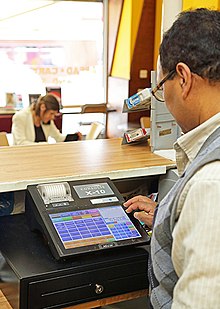
Modern cash annals with touchscreen interface
Registers volition typically characteristic a numerical pad, QWERTY or custom keyboard, bear upon screen interface, or a combination of these input methods for the cashier to enter products and fees past manus and admission information necessary to complete the sale. For older registers as well as at restaurants and other establishments that practice not sell barcoded items, the manual input may exist the only method of interacting with the register. While customization was previously express to larger bondage that could afford to take physical keyboards custom-built for their needs, the customization of register inputs is now more than widespread with the employ of touch screens that can brandish a variety of indicate of sale software.
Scanner [edit]

Modern cash registers may exist connected to a handheld or stationary barcode reader so that a customer'due south purchases can be more chop-chop scanned than would exist possible by keying numbers into the register by hand. The use of scanners should too help prevent errors that result from manually entering the production's barcode or pricing. At grocers, the register's scanner may be combined with a scale for measuring production that is sold by weight.
Receipt printer [edit]
Cashiers are often required to provide a receipt to the client later a purchase has been made. Registers typically use thermal printers to impress receipts, although older dot matrix printers are still in use at some retailers. Alternatively, retailers can forgo issuing paper receipts in some jurisdictions by instead asking the customer for an electronic mail to which their receipt can be sent. The receipts of larger retailers tend to include unique barcodes or other data identifying the transaction then that the receipt tin can be scanned to facilitate returns or other customer services.
Security deactivation [edit]
In stores that use electronic article surveillance, a pad or other surface will be attached to the register that deactivates security devices embedded in or attached to the items being purchased. This volition prevent a client'south buy from setting off security alarms at the store's get out.
Self-service greenbacks register [edit]

Some corporations and supermarkets have introduced self-checkout machines, where the customer is trusted to browse the barcodes (or manually identify uncoded items like fruit), and identify the items into a bagging area.[xviii] The bag is weighed, and the machine halts the checkout when the weight of something in the bag does not match the weight in the inventory database. Normally, an employee is watching over several such checkouts to preclude theft or exploitation of the machines' weaknesses (for case, intentional misidentification of expensive produce or dry goods). Payment on these machines is accustomed past debit card/credit card, or cash via coin slot and bank note scanner. Store employees are as well needed to qualify "age-restricted" purchases, such equally alcohol, solvents or knives, which can either be done remotely by the employee observing the self-checkout, or by ways of a "shop login" which the operator has to enter.
Run into also [edit]
- Credit carte du jour last
- EFTPOS
- Point of sale
- Point of auction brandish
References [edit]
- ^ "Cash annals vs. POS arrangement –what's the difference?".
- ^ "How to Cull a POS Cash Register".
- ^ Cash and Credit Registers, National Museum of American History.
- ^ "Replica of the Ritty Model ane Greenbacks Register". National Museum of American History. Retrieved April 7, 2009.
- ^ "On This Day". The New York Times. January 30, 2002. Retrieved May xviii, 2014.
- ^ "Inventor of the Calendar week: Archive". Massachusetts Institute of Technology. April 2002. Archived from the original on March 2, 2003. Retrieved Apr 7, 2009.
- ^ Kerr, Gordon (2013). Volume of Firsts. RW Press. ISBN9781909284296.
- ^ Bryson, Neb (1994). Made in America: An Informal History of the English language Linguistic communication in the Usa . William Morrow Paperbacks. pp. 114–115. ISBN978-0380713813.
- ^ Brat, Ilan; Zimmerman, Ann (September 2, 2009). "Tale of the Tape: Retailers Take Receipts to Neat Lengths". The Wall Street Journal. p. A1. Retrieved September 2, 2009.
- ^ "Forum relating to the manufacturing activities at the Hollingbury industrial manor, Brighton, during 1960s". Retrieved July 21, 2009.
- ^ "Gross Greenbacks Registers pictures and company history". Retrieved July 21, 2009.
- ^ "Gross Cash Registers". BBC. 1980.
- ^ "Restaurants, paying the nib, receipt, check". Slow Travel Italy. Archived from the original on October 3, 2013. Retrieved September 27, 2013.
- ^ "When in Italy, Keep That Receipt!". Roderickconwaymorris.com. Apr ten, 1992. Retrieved September 27, 2013.
- ^ "Blazon: Bitmap". Papress.com. Archived from the original on March 20, 2014. Retrieved September 27, 2013.
- ^ Wingfield, Nick (April 22, 2013). "Tablets transforming the cash register". The New York Times.
- ^ "Greenbacks Drawers". PCS Technology Ltd. Archived from the original on April xviii, 2012. Retrieved April thirty, 2012.
- ^ "IBM Self Checkout Systems". IBM.
Source: https://en.wikipedia.org/wiki/Cash_register
Posted by: mullanaforeg.blogspot.com


0 Response to "What Denominations Do I Want In My Register"
Post a Comment